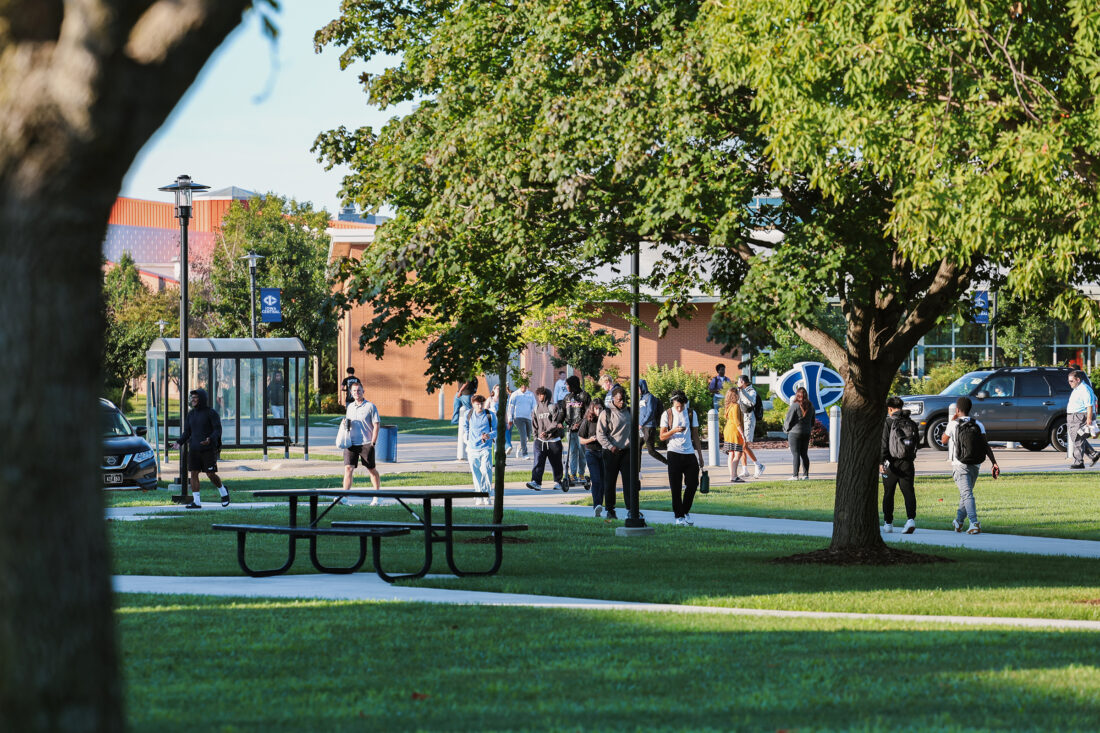Acing your senior year
Scharf helps students navigate college, career decisions
-
-Submitted photo
Students and faculty cross campus on their way to classes on the first day of the fall semester at Iowa Central Community College.
-
-Submitted photo
The Iowa Central Community College courtyard is seen in this aerial view on the first day of the fall semester. Choosing a career and college can be overwhelming for high school seniors, but college and career transition counselors like Iowa Central’s Sara Scharf are here to help.

-Submitted photo
Students and faculty cross campus on their way to classes on the first day of the fall semester at Iowa Central Community College.
One’s senior year of high school is an exciting time, but it can also be one of daunting decisions — including whether to enroll in college or enter the workforce.
Whatever path a student chooses, Sara Scharf — and those in similar positions — can help seniors navigate this crucial time.
Scharf, the director of regional high school partnerships at Iowa Central Community College, visits four area schools each week, where she meets with students individually to help them with their next steps.
“I feel like students put a lot of pressure on themselves to figure out what they want to do, where they want to go,” she said. “But I always tell them, it’s OK right now to be undecided, and it’s actually OK to be undecided throughout the year.”
Choosing a Career

-Submitted photo
The Iowa Central Community College courtyard is seen in this aerial view on the first day of the fall semester. Choosing a career and college can be overwhelming for high school seniors, but college and career transition counselors like Iowa Central's Sara Scharf are here to help.
If a student isn’t sure of a career path or where they want to go to college, the first thing Scharf addresses is learning styles. Is the student more of a hands-on learner or more of a classroom learner and note-taker?
“Some just want to go into the workforce,” she said.
But for those considering college, she asks if they picture themselves doing one, two, four or more years?
For hands-on learners, she said a one- or two-year degree might be a better fit. Others may know they want a bachelor’s degree.
Scharf encourages students to enroll in exploratory classes to help develop their interests. She can even arrange for students to sit in on a college class.
“Even if they are not going to Iowa Central, they can still come and get the experience of, ‘This is what an auto class is like, this is what a welding class is like, this is what an anatomy class looks like.”
The next step might be to set up a job shadow.
“We just had a Manson girl who wanted to do something in the hospital, and she decided that surgical tech, after doing job shadows, was good,” said Scharf.
Attending career days can also be beneficial. For instance, when it comes to health care, she said most students know about nursing, but they might not know about being a medical assistant, med lab tech or dental assistant.
“I think that career days open up students’ eyes,” Scharf said, “especially younger students, sophomores and juniors.”
Choosing a College
Once a student determines their course of study, then it’s time to look at colleges that offer those programs.
“I tell kids, that’s kind of the cool part,” she said, “you get to shop around.”
She encourages students to find the college environment that suits them best, whether that’s a big or small school setting, close to home or farther away. They should also consider the extracurricular activities offered, especially if they want to continue an interest from high school, such as marching band or theater.
Next, they can begin to compare tuition, fees, and other costs, and look at the acceptance process.
If a student knows they want a bachelor’s degree, she said it might be a good idea to check out the three types of colleges — community college, private and state universities — to get a feel for the differences in the types of campuses. If a student knows for sure they want to attend a private school, she recommends visiting two or three to compare and contrast.
“The beginning of senior year is prime college visit time,” said Scharf, specifically October and November.
She added that going on college visits at the end of one’s junior year — whether in person or virtually — is also a good idea.
“But as a senior, we always recommend going on an individual visit,” she said, “because they’re going to tailor it a little bit more toward you if the college offers that one-on-one.”
Once a student decides on a college, the next step is to apply.
At some schools, applying is free, while others charge an application fee. All three state universities in Iowa charge an acceptance fee in addition to the initial application fee.
Colleges may also charge an application fee for housing. If possible, Scharf said students should apply for housing in the fall, as often it’s on a first-come, first-serve basis.
Students also need to learn if their college or program of choice requires any special tests, such as the ACT, SAT or ALEX text.
“A lot of colleges have gone test-optional since COVID,” she said, “so not all students need it.”
Filing the FAFSA
Next on the senior fall to-do list is filling out the FAFSA (Free Application for Federal Student Aid), which opened on Oct. 1 this year. Filling out this form helps determine a student’s eligibility for various types of financial aid, which can include both grants and loans. The FAFSA can be sent to up to 20 schools.
“It’s easier now than it’s ever been,” said Scharf. “The FAFSA uses the IRS data retrieval tool, so a parent should have their taxes readily available, but it should just pull all of their information in.”
The first step is to create an FSA ID, which is how a student and parent sign in. In prior years, Scharf said students had to wait three days to be verified through the Social Security Administration, but now that barrier has been removed.
“So once you create your FSA ID, you can go right in to filling out the FAFSA.”
The student starts the FAFSA online, then invites the parent. Scharf said the whole process can easily be done in 20 to 30 minutes.
“We help students with the FAFSA in our (nine-county) region, even if they’re not going to Iowa Central,” said Scharf.
Any college’s financial aid office will also help students.
“People might assume that they make too much, so they don’t file it,” she said. “But some schools want you to have the FAFSA for scholarships, so we encourage them just to file it, because they might look at that as they’re awarding scholarships.”
In addition, she said any student loans obtained through the FAFSA have the best interest rates.
“Every student qualifies for those regardless of credit score, regardless of family circumstances,” said Scharf.
Applying for Scholarships
Fall is also a key time to begin applying for scholarships — a process which will likely continue throughout the school year.
Scharf recommends that college-bound students create a spreadsheet of all extracurricular activities they are involved in, from 4-H to music to athletics to volunteerism.
“That way, when you go your senior year to apply for these scholarships, and they ask what you’ve been involved in,” Scharf said, “you’ll already have that running list.”
She said some students will even create a resume with a running timeline of activities they’ve been involved in, then upload it with their scholarship applications.
Scharf recommends getting three letters of recommendation to submit with those applications, advising seniors to fill out a “brag sheet” for those writing the letters.
“They can probably see what you do in the classroom, but they might not know that you volunteer at your church; they might not know that you’re involved in 4-H; they might not know that you received a specific award,” she said.
Scharf also encourages seniors to write a personal statement that includes their future goals.
“When you’re applying for a scholarship, you have no idea what the competition is, if there’s 10 candidates or if there’s hundreds of candidates, and you need to make yourself stand out,” said Scharf. “So if you only answer the questions that are provided, a lot of times, you’re maybe not standing out amongst the other candidates.”
Some students have unusual circumstances that may factor into receiving scholarships.
“We encourage them to share what they feel comfortable sharing,” Scharf said, “to show that they could really utilize some of that money to help them through school.”
When seeking scholarships, seniors should check with local service organizations or clubs as well as their parents’ employers. Also check with the college; some award scholarships based on grade-point average.
“Some schools will even use promotions,” she said. “If you come on a visit, you get a scholarship.”
For those attending community college, she said four-year universities often offer transfer scholarships.
Students also need to be aware of scholarship deadlines. Some might be due in December, and others in February.
Paying for College
Several factors can impact the cost of college outside of tuition and fees. Among those are the decision to live on or off campus, meal plans, as well as personal expenses such as books and computers.
When visiting a school, Scharf recommends asking if meals are included in the cost of living on campus. Choosing a meal plan with fewer meals can save money.
Taking dual credit courses in high school is another way to lighten the financial burden. Scharf said the main thing is to be sure those credits transfer wherever the student plans to attend.
She said it’s also a good idea to reach out to the college to learn what resources are available, because a student might qualify for work study or college scholarships.
Finally, students can work with the school’s business office to set up a payment plan and avoid paying a lump sum up front.
Final Steps
Scharf said students will generally get their award letter and financial aid offers from colleges in the spring.
“Based on that,” she said, “some students reevaluate their choice (of college) after they get their financial aid offer.”
Next, if assigned a roommate, students can begin to figure out who’s bringing what and when move-in day is.
Orientations usually follow in the summer.
“I guess the big thing we tell kids is don’t stress. Kids just seem very stressed about picking a college. But it should be fun and exciting,” Scharf said.
“The more work we do their junior and senior year, going on visits, talking to that college. The more steps they put in, they just feel better. But I always tell them, it’s OK if you’re undecided. There’s things we can do to help alleviate that stress.”
College Timeline
Freshman/Sophomore Year
• Focus on grades — GPA matters from day one.
• Get involved in clubs, sports, volunteer work, or jobs to build experience.
• Start exploring interests and careers — Attend Career Days.
• Visit a college or two casually to get a feel.
• Create a four-year plan and review it with your counselor — Include college classes if you plan on taking dual credit classes in high school.
• Attend a local college fair.
• Take high school exploration classes to see if you can find a program you like.
• Start your activity/honors list that you will use when applying to colleges/scholarships.
Junior Year
Fall
• Start researching colleges/programs.
• Meet with your counselor and CCTC (college and career transition counselor) to review your plan, including both high school and college classes (dual enrollment).
• Attend a college fair.
Spring
• Take ACT/SAT (or prep for test-optional schools).
• Narrow college list to a realistic group of schools.
• Visit campuses.
• Complete a job shadow.
• Sit in on college classes to determine if you like a certain program/curriculum.
Summer Before Senior Year
• Write a draft of your college essay/personal statement.
• Work on a resume/activity list
• Look for scholarships
Senior Year
Fall
• Finalize your college list.
• Go on a final college visit to solidify your decision.
• Ask teachers and other appropriate people for letters of recommendation.
• Apply for colleges.
• Request transcripts.
• FAFSA opens Oct. 1 (some schools have priority deadlines in Nov.-Dec).
• Apply for scholarships, some schools have early scholarship deadlines.
Winter
• Submit acceptance fees and housing, if needed.
• Continue applying for scholarships.
• Watch your email/college portals for updates.
Spring
• Compare financial aid offers.
• Make a final decision by May 1.
• Take placement tests if needed.
• Sign up for classes, orientation, housing.
Summer
• Finalize housing, class registration, and preparation for transition.
• Be sure you understand what your bill looks like when college starts: Do you need to take out additional loans, are your scholarships applied to your account, do you need to set up a payment plan?
• Attend orientation.
• Be sure to have your books and supplies.
• Practice self-care and independent skills.
• Reach out to roommates to prepare what you need to bring.







